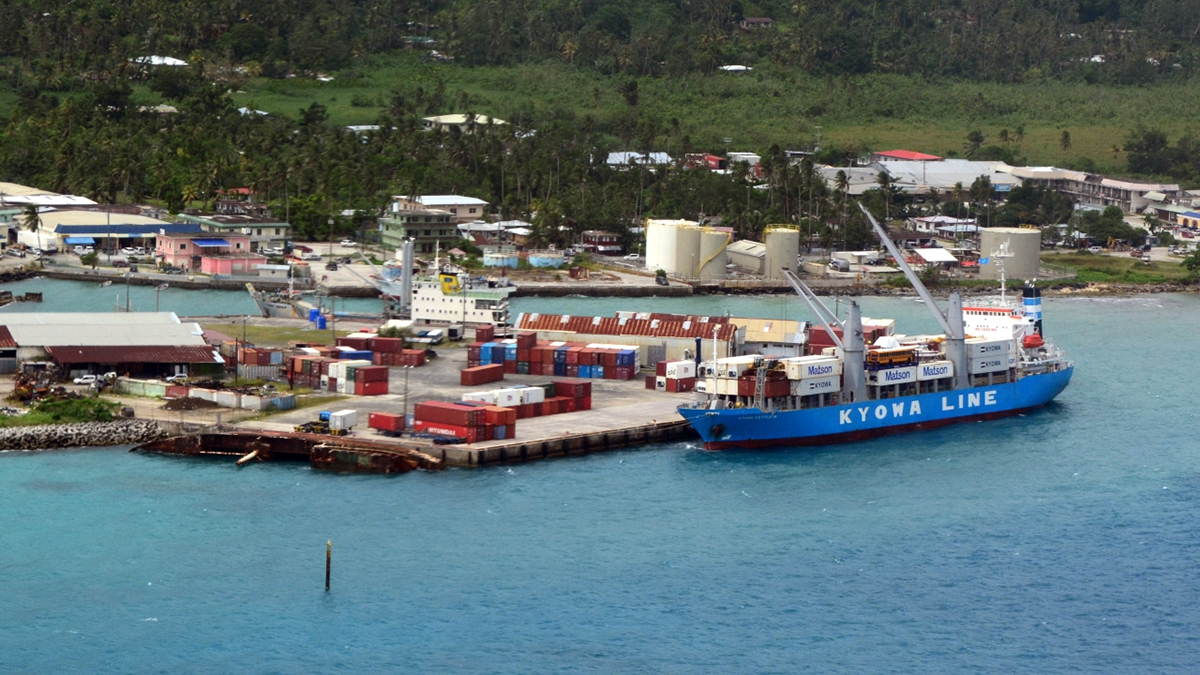Written by: Roel Hoenders and Camille Bourgeon, Article No. 90 [UNCTAD Transport and Trade Facilitation Newsletter N°94 - Second Quarter 2022]
© Jan Hoffmann | Chuuk, Federated States of Micronesia
International shipping plays a central role in global trade, carrying 70% of that trade by value and more than 80% by volume. However, it is also a significant source of greenhouse gas (GHG) emissions, accounting for around 2.89% of global emissions according to the IMO Fourth GHG Study (2020).
The International Maritime Organization (IMO) is the United Nations specialized agency developing global regulations for shipping in areas such as safety, security, and prevention of pollution, including air pollution, from ships.
In April 2018, IMO adopted an Initial Strategy on the reduction of GHG emissions from ships, setting out a vision which confirms IMO’s commitment to reducing GHG emissions from international shipping and to phasing them out as soon as possible. The Strategy is due to be revised and strengthened in 2023. The Initial Strategy contains several candidate GHG reduction measures, categorized into short, mid and long-term measures.
Assessing possible impacts on States of future IMO GHG reduction measures
The Initial Strategy recognizes that the possible impacts on States of candidate GHG reduction measure should be assessed and considered before their adoption and lays out parameters to assess these impacts. These include geographic remoteness, connectivity to main markets, cargo value and type, transport dependency, transport costs, food security, disaster response, cost-effectiveness and socio-economic progress and development. The Procedure for assessing impacts on States of candidate GHG reduction measures is set out in MEPC.1/Circ.885.
It underscores that particular attention in these impact assessments should be paid to the needs of developing countries, especially Small Island Developing States (SIDS) and Least Developed Countries (LDCs). Transport costs are particularly important in the Pacific region which contains some of the States most vulnerable to climate change and who are already facing relatively high shipping and trade costs, being largely dependent on shipping for trade, including imports of essential goods.
With a view to reduce the carbon intensity of operational shipping by at least 40% in 2030, compared with 2008, MEPC 75 approved, in 2020, a short-term measure combining technical and operational energy efficiency requirements.
Box 1: What does the short-term GHG reduction measure mean in terms of new requirements for ships?
Starting from 1 January 2023:
- All ships of 400 GT and above will be required to calculate their Energy Efficiency Existing Ship Index (EEXI) and to implement technical means to improve their energy efficiency. Ships are required to meet a specific required EEXI which is based on a required reduction factor (expressed as a percentage relative to the EEDI baseline) equivalent to EEDI phase 2 or 3, thus creating a level playing field between old and new ships.
- All ships of 5,000 gross tonnage and above will be required to calculate and report their operational carbon intensity using indicators (CII) which link the GHG emissions to the transport work (carrying capacity) of ships. In 2024, ships will be rated (A, B, C, D, E – where A is the best) against a reference line and required reduction factors, which will be incorporated in their mandatory documentation to be issued by Administrations. Ships rated E or D for three consecutive years, will have to submit a corrective action plan, to show how the required index (C or above) would be achieved. Administrations, port authorities and other stakeholders, as appropriate, are also encouraged to provide incentives to ships rated as A or B.
In considering the draft amendments to the International Convention for the Prevention of Pollution from Ships (MARPOL Annex VI), many delegations highlighted that, before adopting the short-term measure, it was essential to undertake a comprehensive assessment of its possible impacts on States. Consequently, the impact assessment was initiated in accordance with the approved terms of reference and a Steering Committee established.
UNCTAD was invited by IMO to undertake, based on a prior assessment of impacts of the proposed measure on the world fleet, a quantitative and qualitative comprehensive assessment of the possible impacts of the IMO measure on States. IMO and UNCTAD, as members of the UN family, have a long-standing collaborative relationship. This collaboration has been particularly close during this assessment.
Box 2: Comprehensive impact assessment of the short-term measure – Findings from UNCTAD analysis
To deliver on the task at hand, UNCTAD adopted a two-pronged approach involving two interlinked steps. The first step involved an assessment of the changes in maritime logistics costs – including shipping (transport) and time-related costs - resulting from the IMO GHG short-term measure. In the second step, UNCTAD used a global trade model to simulate the impact of estimated changes in maritime logistics costs, trade and GDP.
The exercise was complex. It involved calculating changes in cost intensity of different ship types and distance travelled (see figure 1), translating these changes into shipping and transport costs (beyond maritime), calculating transit times at sea and trade modelling. UNCTAD’s assessment covered: all ships covered by the regulations (2019), all ships’ journeys (2019), assessing impact on logistics costs (for 230 territories), trade flows (imports, exports and GVC-related trade) (for 184 economies) and GDP (for 184 economies).
It compared a regulatory scenario consisting of only EEDI requirements being adopted (baseline scenario) with 3 alternative regulatory scenarios:
- “EEXI-only” scenario included EEXI requirements only
- “High-GHG” scenario included both EEXI and CII requirements, with a CII average reduction requirement of 21.5 per cent between 2019 and 2030
- “Low-GHG” scenario included both EEXI and CII requirements, with a CII average reduction requirement of 10.2 per cent between 2019 and 2030
The CII requirements agreed at MEPC 76 were in between the “Low-GHG” and “High-GHG” scenarios.
Although different countries are affected differently (for instance, depending on their trade profile) the report found that short-term GHG reduction measure could entail, for 2030:
- An upward average increase in maritime logistics costs ranging from 1.6% (EEXI-only scenario), 3.1% (Low-GHG) and 7.6% (High-GHG)
- Trade reduction at the global level ranging between 0.10% (EEXI-only), -0.49% (High-GHG) and -0.21% (Low-GHG)
- GDP reduction at the global level ranging between -0.01% (EEXI-only), -0.04% (High-GHG) and 0.02% (Low-GHG)
These figures can be considered small, when comparing the resulting logistic cost increase to typical market variability of freight rates. The global impacts on GDP and trade flows can also be considered small when compared to the long-term impact disruption of the pandemic or climate change factors. For certain countries, particularly Pacific SIDS and LDCs, the impact is relatively higher, suggesting the need for support to mitigate and alleviate potential impacts on real income and trade flows.
Source: UNCTAD (2021) UNCTAD Assessment of the Impact of the IMO Short-Term GHG Reduction Measure on States
Figure 1: Percentage change in cost intensity by ship segment, average size and median distance travelled
Source: UNCTAD (2021) UNCTAD Assessment of the Impact of the IMO Short-Term GHG Reduction Measure on States
The impact assessment report also suggested possible considerations for future impact assessments of mid- and long-term GHG reduction measures for shipping, in particular (1) to review and determine the availability, reliability, and level of granularity of data and identify main gaps relating to transport cost data pertaining to developing countries, in particular SIDS and LDCs; (2) and to identify capacity-building needs to improve impact assessments, including building the capacity of developing countries, in particular SIDS and LDCs to collect relevant data.
New IMO project seeks to improve availability of maritime transport costs data in the Pacific region in the context of shipping decarbonization
In considering the outcomes of the comprehensive impact assessment, the seventy-first session of the IMO Technical Cooperation Committee (TC) noted the advice from the Secretariat that a number of IMO projects might be of assistance in providing analysis and data, for example the Global Maritime Technology Cooperation Centres (MTCCs) Network, many delegations also supported the strengthening of MTCCs globally and their possible involvement in the delivery of IMO's technical cooperation activities.
In response to the observations of MEPC and TC, the IMO Secretariat initiated a project aiming to improve the availability of relevant maritime transport costs data for the Pacific SIDS/Pacific Region with a view to facilitating future assessments of the possible impacts on States of potential GHG reduction measures in shipping, including, as appropriate, carbon pricing instruments. To assist in this, the project aims to establish interim baselines and to initiate the modelling of the impact on Pacific SIDS of a hypothetical increase in transport costs or change in connectivity patterns. Central to the project’s success will be its ability to identify the foundation of a system of continued monitoring and collection of data on maritime transport costs in the Pacific region.
The activity will be implemented by MTCC-Pacific, a centre of expertise established by IMO as part of the Global MTCC Network (GMN) and hosted by the Pacific Community (SPC) and the Secretariat of the Pacific Regional Environment Programme (SPREP).
To ensure that the outcomes of the project are transparent and not policy prescriptive, a broad range of organizations, institutions and resources with relevant experience and expertise, including UNCTAD, will to be involved.
The main outcome of this project will be a Study on maritime transport costs data in the Pacific region which is to be submitted to the IMO Secretariat by 1 October 2022.
It is also expected that the project will identify and initiate a possible permanent partnership or structure for the ongoing collection and sharing of maritime transport costs data and other relevant statistics for Pacific SIDS. The project is also expected to enhance the understanding of the determinants of maritime freight rates in the Pacific region.
The project is funded by the IMO GHG-TC Trust Fund.
Interested stakeholders are invited to liaise with the IMO Secretariat ([email protected]) for more information.
About the authors:
- Roel Hoenders | Head, Air Pollution and Energy Efficiency | Marine Environment Division, IMO | [email protected]
- Camille Bourgeon | Technical Officer | Marine Environment Division, IMO | [email protected]



